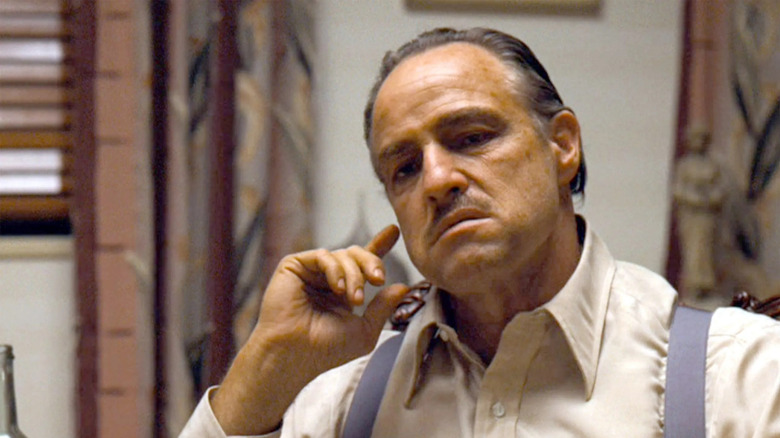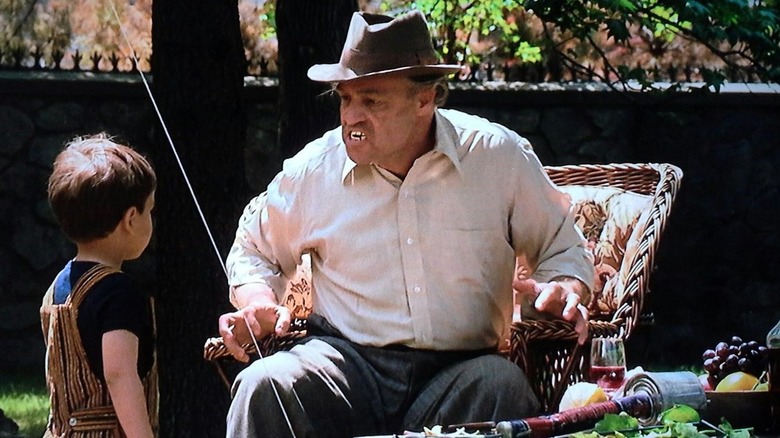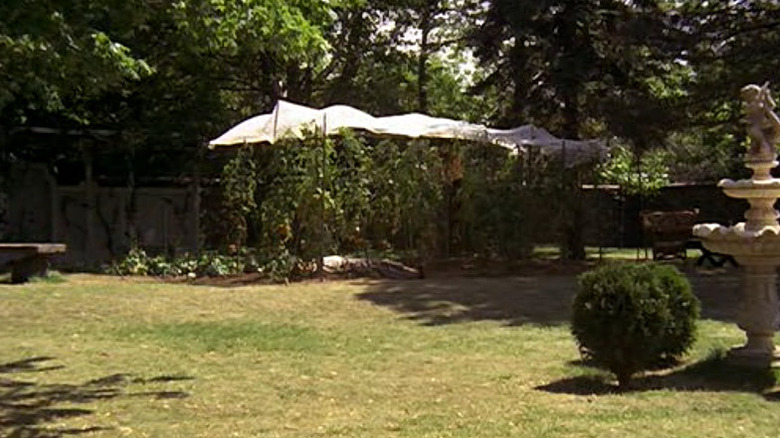The Classic Godfather Scene Francis Ford Coppola Had To Fight For
The more one studies the making of 1972's "The Godfather," the more two things become abundantly clear. One: Francis Ford Coppola was hellbent on adapting Mario Puzo's novel to the screen with a strong eye toward character and theme, an approach that Robert Evans and the regime of Paramount Pictures at the time did not understand nor believe in. And two: Coppola was incredibly miserable while making the film given all of the hurdles he had to get over and enemies he had to outwit, and was just barely able to complete the movie in the way he wanted to.
While there are many examples that illustrate this struggle, one of the most illuminating concerns the scene in which the Godfather, Don Vito Corleone (Marlon Brando), dies peacefully yet ignominiously (especially for a once powerful and feared man) in a tomato patch at his home, suffering a heart attack while playing with his grandson, who's oblivious to the older man's plight. It's one of many improvised moments in the film that is emotionally as well as thematically resonant, and as such tends to be thought of as one of the best scenes in the film. Coppola not only had to fight for the scene's inclusion, but also had to employ some quick thinking (helped in part by his star, Brando) in order for the scene to be shot at all, let alone end up in the final cut.
Coppola makes art out of entertainment
Initially, Coppola wasn't at all interested in making a movie out of "The Godfather." As he's stated in various places (including his own director's commentary for the film as well as on The Howard Stern Show), he thought that Puzo's novel was "very sleazy," and was more interested in pursuing his pet projects at his own company-cum-artist's collective, American Zoetrope. For his part, Puzo was just happy to have his novel be so successful, enough that Paramount bought it and commissioned him to write a screenplay that would move the action from the 1940s to the 1970s, be set in St. Louis instead of New York City to better help with tax breaks during filming, and so on.
However, due to American Zoetrope being in dire financial straits, the director's friend George Lucas convinced Coppola to take the "Godfather" gig as a way of making some much-needed bank, and Coppola began to see a lot of creative opportunities within Puzo's material that he could latch onto — especially the predominant theme of family, something that had been a huge part of Coppola's work since his debut feature, "Dementia 13."
Unfortunately, Coppola was only able to get the job in part because the studio believed that the young and still relatively-unknown director would make it for cheap while being easily manipulated. As the filmmaker recalled during that Stern appearance:
"There had been a few Mafia movies before, and they had all been flops. So all the big directors turned them down. They eventually decided to make it very low-budget. And I was also a screenwriter, so they thought that would get a free rewrite out of me."
One can imagine how incensed Paramount were when Coppola began insisting that the film remain a period piece, be shot on location in NYC, and other such stipulations which moved "The Godfather" away from being the quick, cheap, and dirty genre film the studio initially planned on.
Coppola and Brando get the key scene
As Coppola recently recounted to CBS Sunday Morning, the scene of Don Vito's demise was originally not even planned to be shot, with the Paramount executives cutting it at a script level. However, the director was not to be so easily deterred, and planned to sneak the shooting of the scene while on location for another, lengthier sequence that was absolutely intended for inclusion: the scenes involving the outdoor wedding of Connie Corleone (Talia Shire). While shooting continued for that sequence, Coppola had a little tomato patch set up nearby, knowing he'd have a few moments in between setups of the wedding to try and quickly capture the scene with two cameras.
Despite those plans, the director was nearly thwarted by a representative of the studio who was on set and tried to get this additional shoot shut down, forcing him and Brando to quickly improvise when the young boy in the scene was making the quick shoot take longer than hoped for. As Coppola recalled:
"I rolled the camera, and Brando saw I was under trouble, and he said 'Lemme show you — I'll do something I do with my kids.' He loved kids, Brando. And he took the orange peel, put it in his mouth, and scared the little kid, and the little kid was scared, and ran away. And the guy came back and said 'That's it, wrap!'"
Later, according to Coppola's commentary track, the director secretly went back and got a wide shot of the Godfather lying dead in the tomato patch while the boy runs away, providing a haunting ending to the scene that it needed. Without the quick thinking of the director and his actor, not to mention the passion both clearly shared for the film and the scene, it may never have been shot, let alone ended up in the film, where it remains an indelible and essential moment.


